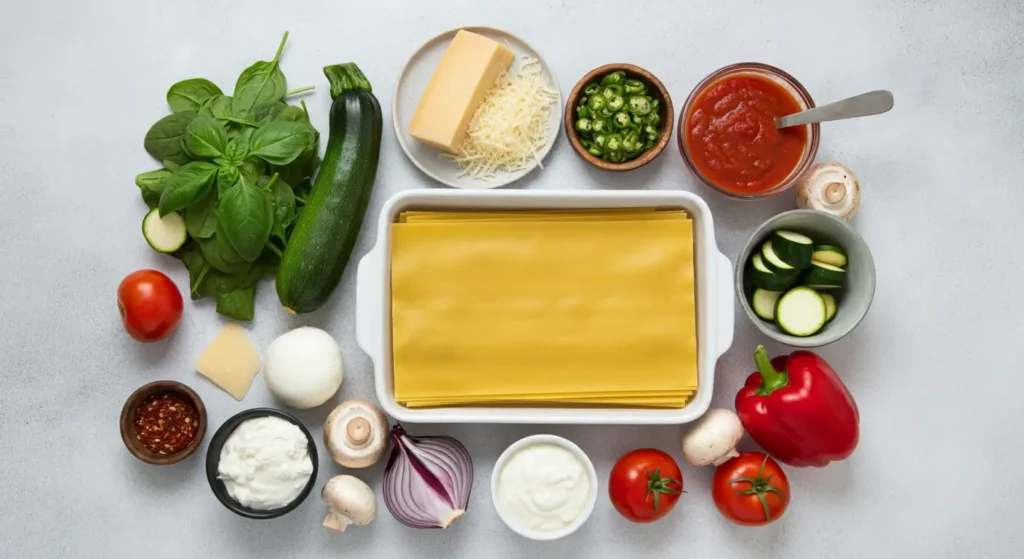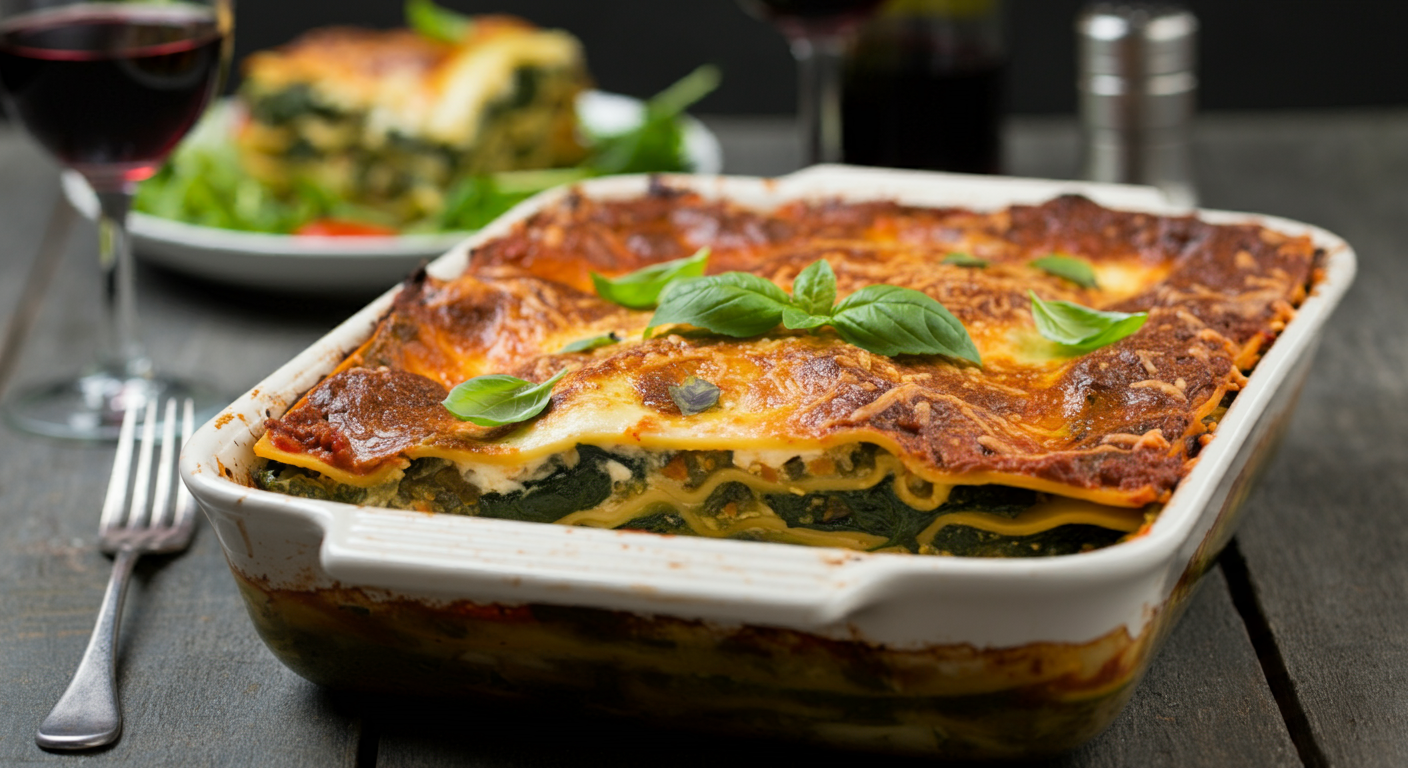Transformative Vegetarian Lasagna: The Best Recipe Revealed!
Introduction
Lasagna is one of those comforting dishes that can bring a family together, especially when it’s packed with fresh vegetables and wholesome flavors. It’s a dish that transcends generations, with each family adding their own twist to the classic recipe. In this article, I’ll share my ultimate vegetarian lasagna recipe, complete with tips, nutritional insights, and variations to suit any dietary preference. Whether you are an experienced chef or just starting in the kitchen, this recipe is crafted to be easy to follow and deeply satisfying. The beauty of vegetarian lasagna lies in its versatility, allowing you to incorporate seasonal vegetables and adjust the ingredients based on your preferences.
Key Aspects of Vegetarian Lasagna

Vegetarian lasagna is not just a meatless version of the classic dish; it’s an opportunity to explore a variety of flavors and textures. The key to a successful vegetarian lasagna lies in the quality of ingredients and the balance of flavors. Studies show that incorporating a range of vegetables not only enhances the taste but also boosts the nutritional profile of the dish. For instance, using fresh, seasonal produce not only supports local farmers but also ensures that your lasagna is bursting with flavor and nutrients.
The Nutritional Benefits
One of the primary benefits of vegetarian lasagna is its healthfulness. By focusing on vegetables, you’re increasing your intake of vitamins, minerals, and antioxidants. Spinach, for example, is rich in iron and vitamins A and C, while zucchini is low in calories and high in fiber. Mushrooms add a unique umami flavor and are packed with antioxidants and vitamin D. This dish can be a fantastic way to sneak in more servings of vegetables into your diet, making it a great option for families looking to eat healthier.
Flavor Profiles
When crafting your vegetarian lasagna, consider the flavor profiles of the ingredients you choose. Fresh herbs like basil, oregano, and thyme can elevate the dish significantly. These herbs not only add flavor but also come with their own health benefits, such as anti-inflammatory properties. Additionally, the use of a good-quality marinara sauce can tie all the flavors together, providing a rich and savory base for your lasagna.
Ingredients List
Here’s what you’ll need to create this delicious vegetarian lasagna:

- Lasagna noodles (use gluten-free if needed)
- Ricotta cheese
- Mozzarella cheese (shredded)
- Parmesan cheese (grated)
- Spinach (fresh or frozen)
- Zucchini (sliced)
- Mushrooms (sliced)
- Bell peppers (chopped)
- Marinara sauce
- Olive oil
- Garlic (minced)
- Salt and pepper (to taste)
- Herbs (basil, oregano, thyme)
Ingredient Substitutions
If you have specific dietary needs or preferences, there are plenty of substitutions you can make. For instance, if you’re lactose intolerant or following a vegan diet, there are excellent dairy-free cheese alternatives available on the market. You can also replace ricotta with blended tofu mixed with nutritional yeast for a creamy texture. For the noodles, there are various options, including whole wheat or lentil-based noodles, which can add additional fiber and protein to your dish.
Step-by-Step Instructions
Creating a vegetarian lasagna is straightforward. Here’s how to do it:
- Preheat the oven to 375°F (190°C). Preheating is crucial as it ensures that your lasagna cooks evenly.
- Prepare the vegetables: In a skillet, heat olive oil over medium heat. Add minced garlic, followed by zucchini, mushrooms, and bell peppers. Sauté until tender, about 5-7 minutes. This step helps to release the flavors of the vegetables and reduces excess moisture, preventing a watery lasagna.
- Mix the cheeses: In a bowl, combine ricotta, half of the mozzarella, and Parmesan. Season with salt, pepper, and herbs. Mixing the cheeses together not only enhances the flavor but also creates a creamy filling that binds the layers together.
- Assemble the lasagna: In a baking dish, start with a layer of marinara sauce. Place a layer of noodles, followed by a portion of the cheese mixture, sautéed vegetables, and more marinara. Repeat these layers, finishing with noodles topped with sauce and the remaining mozzarella. The layering process is essential for achieving that classic lasagna structure.
- Bake: Cover the dish with foil and bake for 30 minutes. After that, remove the foil and bake for an additional 15 minutes, or until the cheese is bubbly and golden. Covering the dish initially helps to steam the lasagna, ensuring that all the ingredients meld together beautifully.
- Let it cool and serve: Allow the lasagna to sit for a few minutes before slicing. This resting period helps the layers to set, making it easier to serve.
Nutritional Value
| Ingredient | Benefits |
|---|---|
| Spinach | High in iron and vitamins A and C |
| Zucchini | Low in calories, high in fiber |
| Mushrooms | Rich in antioxidants and vitamin D |
| Cheese | Good source of calcium and protein |
| Marinara sauce | Contains lycopene, beneficial for heart health |
Nutritional Breakdown
Understanding the nutritional value of your ingredients can help you make informed choices. For instance, spinach is not only a powerhouse of nutrients but also adds a vibrant color to your lasagna. Zucchini contributes moisture and a slight sweetness, balancing the acidity of the marinara sauce. Mushrooms bring depth to the flavor profile, while the cheeses provide creaminess and richness.
Health Benefits of Key Ingredients
- Spinach: This leafy green is packed with iron, which is essential for blood production and energy levels. It’s also high in vitamins A and C, which are important for immune function and skin health.
- Zucchini: Low in calories and high in water content, zucchini is a great addition for hydration and can aid in digestion due to its fiber content.
- Mushrooms: These fungi are not only flavorful but also contain compounds that can boost the immune system. They are a good source of vitamin D, especially when exposed to sunlight.
- Cheese: While cheese can be high in fat, it also provides calcium, which is vital for bone health. Using a mix of cheeses can help balance flavor and texture.
Benefits of Vegetarian Lasagna
Vegetarian lasagna is not only delicious but also offers numerous health benefits. It’s a fantastic way to incorporate more vegetables into your diet, providing essential nutrients without the extra calories found in traditional meat-based lasagna. For instance, using seasonal vegetables enhances flavor and nutritional value, making each bite a wholesome experience.
Real-Life Examples
I remember the first time I made vegetarian lasagna for my family. They were skeptical at first, expecting the typical meaty version they were used to. However, once they took a bite, their expressions changed completely. The layers of fresh vegetables, creamy cheese, and rich marinara sauce created a dish that was not only satisfying but also packed with flavor. It was a transformative moment that opened their eyes to the possibilities of vegetarian cooking.
Overcoming Challenges
One common challenge when making lasagna is ensuring it doesn’t turn out watery. To address this, be sure to drain any excess moisture from the vegetables before layering. Additionally, using a thicker marinara sauce can help maintain the desired texture. If you find your lasagna is still watery, you can try adding breadcrumbs to the layers, which will absorb some of the moisture.
Tips for Success
- Use Fresh Ingredients: Whenever possible, opt for fresh, seasonal vegetables. They not only taste better but also enhance the overall nutritional value of your dish.
- Don’t Overcook the Noodles: If you’re using traditional lasagna noodles, undercook them slightly before layering. They will continue to cook in the oven and absorb some of the sauce, preventing them from becoming mushy.
- Experiment with Spices: Don’t be afraid to add your favorite spices to the cheese mixture or the marinara sauce. A pinch of red pepper flakes can add a nice kick, while Italian seasoning can enhance the overall flavor.
Future Trends
As more people adopt plant-based diets, the demand for vegetarian recipes continues to rise. Expect to see innovations in ingredients, such as the use of alternative cheeses and gluten-free noodles, making vegetarian lasagna even more accessible and appealing. Additionally, the trend of meal prepping is gaining popularity, and vegetarian lasagna is an excellent dish for this purpose. It can be made in large batches and stored for easy meals throughout the week.
Data-Driven Insights
According to a recent survey, over 30% of Americans are now incorporating more plant-based meals into their diets. This shift is not just a trend but a reflection of changing attitudes towards health and sustainability. As a result, restaurants and food brands are increasingly offering vegetarian options, making it easier for consumers to choose plant-based meals.
Tips and Tricks
- Preparation: Take the time to prepare your ingredients ahead of schedule for a smoother cooking process. Chop your vegetables the night before or make your marinara sauce in advance to save time on the day you plan to cook.
- Flavor Enhancements: Add spices like red pepper flakes or smoked paprika to elevate the flavor profile. A drizzle of balsamic glaze over the top before serving can also add a delightful sweetness.
- Storage: To reheat your lasagna, simply cover it with foil and bake at 350°F (175°C) until it’s warmed through. Vegetarian lasagna can be stored in the refrigerator for up to three days or frozen for later use.
Variations and Adaptations
This recipe is versatile! You can easily adapt it to fit various dietary needs:
- Gluten-Free: Use gluten-free lasagna noodles or even zucchini slices as a substitute for traditional noodles.
- Dairy-Free: Substitute cheese with plant-based alternatives. Nutritional yeast can also provide a cheesy flavor without the dairy.
- Protein-Packed: Add lentils or chickpeas for extra protein. These ingredients can be mixed into the vegetable layer or added to the marinara sauce.
Creative Twists
Consider adding different vegetables based on the season. In the summer, you might include fresh tomatoes and bell peppers, while in the fall, roasted butternut squash and kale can add a delicious twist. You can also experiment with different sauces, such as pesto or a white sauce, to create unique flavor combinations.
International Influences
You can also incorporate flavors from different cuisines into your vegetarian lasagna. For example, adding some ricotta mixed with feta and spinach can give a Greek twist, while using roasted red peppers and olives can create a Mediterranean flavor profile. Alternatively, a spicy Mexican-inspired lasagna could include black beans, corn, and a chipotle-infused sauce.
FAQs
Q: Can I use different vegetables?
A: Absolutely! Feel free to experiment with your favorite vegetables, such as broccoli, eggplant, or even roasted red peppers. The key is to balance the flavors and textures.
Q: How do I store leftovers?
A: Store in an airtight container in the refrigerator for up to three days. To reheat, simply cover with foil and bake at 350°F (175°C) until heated through.
Q: Can I make this lasagna in advance?
A: Yes! You can assemble the lasagna a day ahead and store it in the refrigerator before baking. Just be sure to cover it tightly with foil.
Q: What can I serve with vegetarian lasagna?
A: A simple green salad with a light vinaigrette pairs beautifully with lasagna. Garlic bread or a side of roasted vegetables can also complement the dish nicely.
Q: Is it possible to freeze vegetarian lasagna?
A: Yes, you can freeze vegetarian lasagna before baking. Just wrap it tightly in plastic wrap and foil. When you’re ready to bake it, remove the plastic and bake from frozen, adding extra time to ensure it cooks through.
Additional Insights on Vegetarian Cooking
Vegetarian cooking is not just about eliminating meat; it’s about discovering new flavors and textures. The culinary world is rich with ingredients that can be utilized to create satisfying and nutritious meals. Here are some additional insights to enhance your vegetarian cooking experience:
Emphasizing Whole Foods
Focus on using whole, unprocessed foods in your vegetarian cooking. This means incorporating whole grains, legumes, nuts, seeds, and a variety of fruits and vegetables. Whole foods are not only healthier but also provide a broader range of nutrients compared to processed alternatives.
Exploring Global Cuisines
Vegetarian cooking can be inspired by cuisines from around the world. Indian cuisine, for example, offers a plethora of vegetarian dishes rich in spices and flavors. Dishes like chana masala (chickpea curry) and palak paneer (spinach and cheese) are not only delicious but also packed with nutrients. Similarly, Mediterranean cuisine emphasizes vegetables, legumes, and healthy fats, making it a fantastic source of vegetarian recipes.
Cooking Techniques
Experiment with different cooking techniques to bring out the best in your ingredients. Roasting vegetables can enhance their natural sweetness and flavor, while sautéing can add a depth of taste through caramelization. Grilling can impart a smoky flavor, making vegetables even more appealing. Consider using a combination of cooking methods in your vegetarian lasagna to create a dish with complex flavors and textures.
Meal Prep and Planning
Meal prepping can be a game-changer for those looking to incorporate more vegetarian meals into their diet. Take some time each week to prepare ingredients in advance. Chop vegetables, cook grains, and prepare sauces so that you can quickly assemble meals throughout the week. This not only saves time but also encourages healthier eating habits.
Engaging the Family
Involve your family in the cooking process. Cooking together can be a fun and educational experience, especially for children. Encourage them to help with washing vegetables, measuring ingredients, or even assembling the lasagna layers. This not only fosters a love for cooking but also helps them develop healthy eating habits.
Conclusion
In conclusion, this vegetarian lasagna recipe is a delicious and nutritious option that can satisfy even the most discerning palates. By incorporating a variety of fresh vegetables, quality cheeses, and flavorful herbs, you can create a dish that is both comforting and healthy. Whether you’re looking to impress guests or simply enjoy a hearty meal at home, this recipe is sure to become a favorite in your household.
So, gather your ingredients, roll up your sleeves, and get ready to experience the transformative power of vegetarian lasagna. Don’t forget to share your experience in the comments below, and if you enjoyed this recipe, consider sharing it with friends or subscribing for more delicious vegetarian recipes!

Vegetarian Lasagna
Ingredients
Lasagna Base
- 9 pieces Lasagna noodles Use gluten-free if needed
- 1 cup Ricotta cheese
- 2 cups Mozzarella cheese, shredded
- 1/2 cup Parmesan cheese, grated
Vegetable Layer
- 2 cups Spinach, fresh or frozen
- 1 medium Zucchini, sliced
- 1 cup Mushrooms, sliced
- 1 medium Bell pepper, chopped
Sauce and Seasoning
- 2 cups Marinara sauce Use a good quality sauce
- 2 tablespoons Olive oil For sautéing
- 3 cloves Garlic, minced
- to taste Salt and pepper
- to taste Herbs (basil, oregano, thyme) Fresh or dried
Instructions
Preparation
- Preheat the oven to 375°F (190°C).
- In a skillet, heat olive oil over medium heat. Add minced garlic, followed by zucchini, mushrooms, and bell peppers. Sauté until tender, about 5-7 minutes.
- In a bowl, combine ricotta, half of the mozzarella, and Parmesan. Season with salt, pepper, and herbs.
Assembly and Baking
- In a baking dish, start with a layer of marinara sauce. Place a layer of noodles, followed by a portion of the cheese mixture, sautéed vegetables, and more marinara. Repeat these layers, finishing with noodles topped with sauce and the remaining mozzarella.
- Cover the dish with foil and bake for 30 minutes. After that, remove the foil and bake for an additional 15 minutes, or until the cheese is bubbly and golden.
- Allow the lasagna to sit for a few minutes before slicing.

